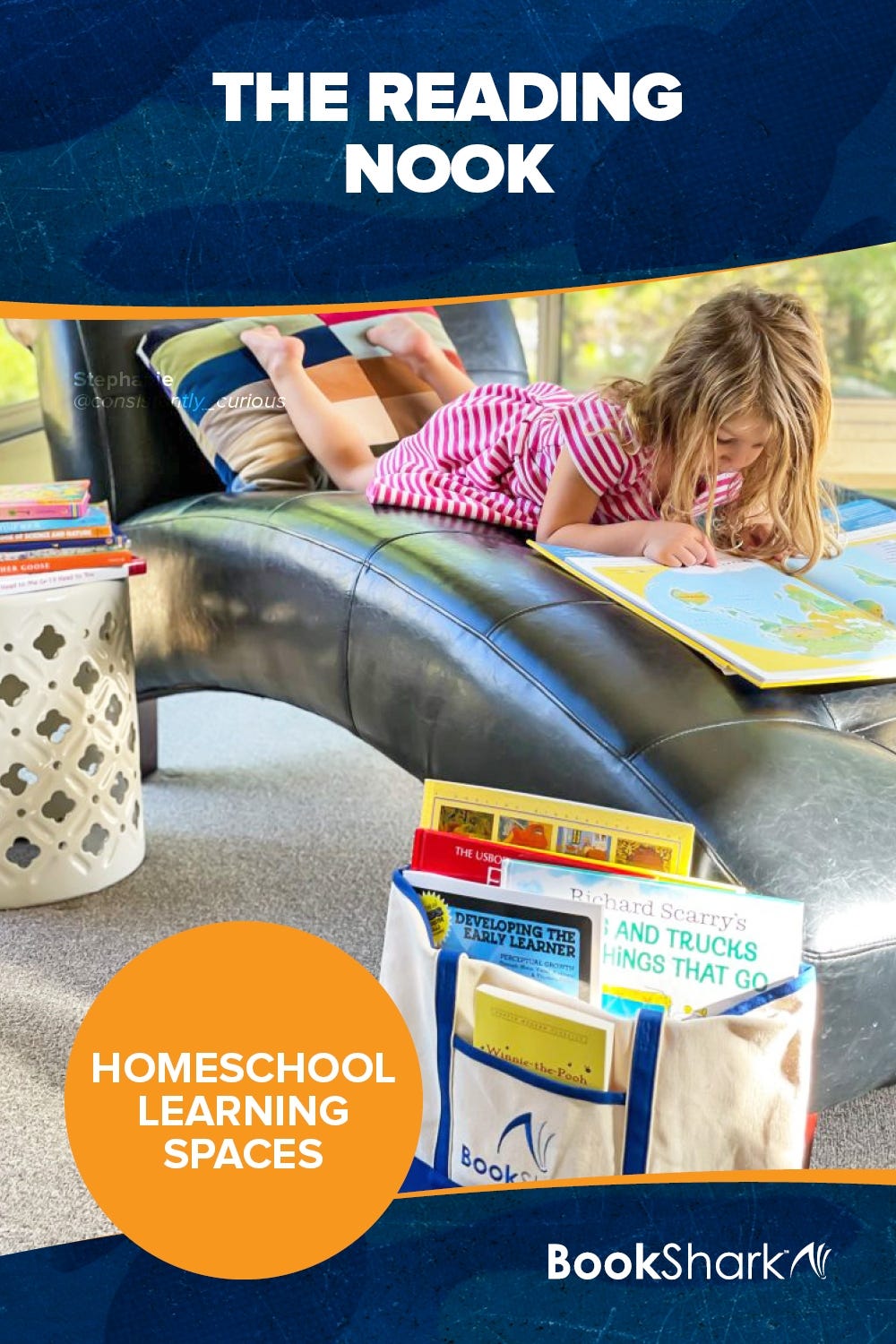




Homeschool Learning Spaces: The Reading Nook

No matter what style of homeschooling you follow, reading is probably a very strong part of your homeschooling journey because reading is one of the best ways to learn about the world, all from the comfort of your own home.
- Unschoolers read.
- Relaxed homeschoolers read.
- Charlotte Mason homeschoolers read.
- Montessori followers read.
- Classical homeschoolers read.
- All homeschoolers read!
Since reading is a natural part of homeschooling, it’s only natural that you want your learning space to include a comfortable reading nook. But what do you do when you don’t have the space or the money to set up the reading nook of your dreams?
How to Set Up a Reading Nook When You Have No Space
Our family has lived in so many houses over the years that we often joke we are semi-nomadic homeschoolers. In all of our homes and in all of our learning spaces, we have somehow never ended up with a nice reading nook or a room dedicated to bookshelves and beanbags.
But no matter our circumstances, I always make an effort to set up an area that invites the kids to snuggle up with a good book.
Right now, our homeschool room is a corner in our basement toy room. There is not much space there for beanbags and couches, so the kids tend to do a lot of reading in their bedrooms, on their beds. The kids may keep the books they are reading in their rooms for accessibility, but the rest stay in the basement until they are needed for homeschool lessons. With this book storage system, my kids always have access to great reading material while books that are not in use are stored safely for future enjoyment.
Informal Reading Space Ideas for Homeschoolers

You don’t have to have a formal reading nook set up in order to include a reading space in your homeschool. You can designate these areas for reading, at least part of the time:
- Living room couch
- Dining room table
- Toy room floor (lie on a blanket)
- Child-sized bean bag chairs
- Child’s bed
- Front or backyard (think blanket, lawn chair, porch swing, etc)
- Cardboard box reading fort
- Blanket fort
Really, any place that the kids find comfortable for reading will work.
Of course the couch or bed isn’t always a reading nook, but during reading time, each place transforms into serving the purpose. Maybe you have a special blanket, pillow, or other prop that signals the place is now being use for reading.
If your child is a relucant reader, working together to create an inviting space that’s reserved only for reading (at least during reading times) is a sneaky way to inspire more interest.
Think about fabrics, comfortable poses, and lighting when choosing and designing your reading nooks.
In a large homeschooling family, it can be difficult for kids to find a quiet spot to read. But when there are a lot of comfortable reading options available, kids will have an easier time settling down to devour a book.
If you have a specific time for independent reading each day, each child can go to their preferred reading nook.
Practical, Child-Friendly Book Storage
If you’ve ever tried to mix little kids and books, then I’m sure you have experienced the joys of kids using books as stepping stones – and the damaged books that follow these activities. I am embarrassed to say we have lost more than our fair share of books to this activity.
But kids have an easier time taking care of their books when they have an easily accessible spot for book storage.
Book Storage for Little Kids: Baskets
I don’t know about other homeschooling families, but I have never been able to get my little kids to put books back on the shelf regularly. And you can bet your bottom dollar that the preschooler is never going to get those books to stand up nicely on that bookshelf.
So how do I store and organize books in a child-friendly way that still keeps the books accessible and well taken care of?
Baskets are my solution!
We have a handful of square wicker baskets for the younger kids’ books. The kids simply have to set their books in the baskets when they’re done reading.
With the basket method, the books look tidy, they’re out of the way, and nobody uses the books as stepping stones. The real trick is teaching the kids to set the books in the baskets nicely rather than tossing them in from across the room.
Book Storage for Older Kids: Shelves
My older kids are capable of putting books on a bookshelf when they are done reading. So in addition to some baskets, we have a couple of bookshelves for their books.
Sometimes the shelves are a nice fit and the books can stand up properly. Other times the shelves are an awkward fit and the books have to stack on top of each other. But as long as the spine is out and the books are orderly, I’m a happy momma.
Currently, our homeschool room has really big and awkward shelving units. These are not even close to the proper size for a stereotypical book storage space. But that’s okay. We make do with what we have. One day when I’m rich and have my dream house, I’ll have wall to wall bookshelves filled with books. There will be homeschooling books, educational books, entertaining books, and more. I’ll put Belle’s library to shame. But until then, I am happy with the space, and the book storage, that I have.

About the Author
Charlene Hess spent many years teaching before she had her own kids. She now has 7 of her own, whom she has been homeschooling for the last 10 years. Although she still teaches other children outside of her home, she finds great joy in exploring the world with her family.
Charlene has participated in many leadership trainings with John C. Maxwell. She and her husband blog about their homeschooling and parenting adventures at Hess Un-Academy.
